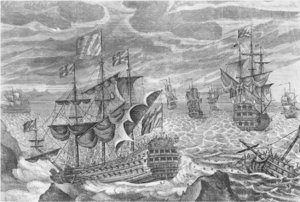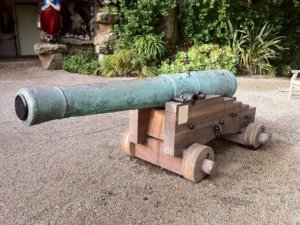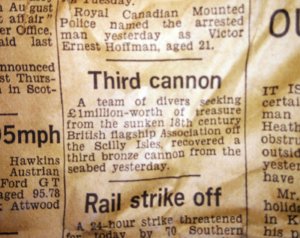Many thanks for this information of your interesting finding.
I was searching a little bit and found this information about the ship and her loss near Scilly
The
Scilly naval disaster of 1707 was the loss of four warships of a
Royal Navy fleet off the
Isles of Scilly in severe weather on 22 October 1707. Between 1,400 and 2,000 sailors lost their lives aboard the wrecked vessels, making the incident one of the worst maritime disasters in British naval history.
[2] The disaster has been attributed to a combination of factors such as the
navigators' inability to accurately calculate their
positions, errors in the available charts and pilot books, and inadequate compasses.
Background
From 29 July to 21 August, 1707, during the
War of the Spanish Succession, a combined British,
Austrian and
Dutch force under the command of
Prince Eugene of Savoy besieged the French port of
Toulon. Great Britain dispatched a fleet to provide naval support led by the
Commander-in-Chief of the British Fleets,
Sir Cloudesley Shovell. The ships sailed to the Mediterranean, attacked Toulon and managed to inflict damage on the French fleet caught in the siege. However, the overall campaign was unsuccessful, and the British fleet was ordered to return home, setting sail from
Gibraltar for
Portsmouth in late September. The force under Shovell's command comprised fifteen
ships of the line (
Association,
Royal Anne,
Torbay,
St George,
Cruizer,
Eagle,
Lenox,
Monmouth,
Orford,
Panther,
Romney,
Rye,
Somerset,
Swiftsure,
Valeur) as well as four
fireships (
Firebrand,
Griffin,
Phoenix,
Vulcan), the
sloop Weazel and the
yacht Isabella.
Loss of the ships

The Isles of Scilly. The
Western Rocks,
Crim Rocks and
Bishop Rock all are in the lower left of this image.
Shovell's fleet of twenty-one ships left Gibraltar on 29 September, with
HMS Association serving as his own flagship,
HMS Royal Anne as flagship of
Vice-Admiral of the Blue Sir George Byng and
HMS Torbay as flagship of
Rear-Admiral of the Blue Sir John Norris. The passage was marked by extremely bad weather and constant
squalls and
gales. As the fleet sailed out on the
Atlantic, passing the
Bay of Biscay on their way to England, the weather worsened and storms gradually pushed the ships off their planned course. Finally, on the night of 22 October 1707
Old Style, (2 November 1707 by the
modern calendar), the squadron entered the mouth of the
English Channel and Shovell's
sailing masters believed they were on the last leg of their journey. The fleet was thought to be sailing safely west of
Ushant, an island outpost off the coast of
Brittany. However, because of a combination of the bad weather and the mariners' inability to accurately calculate their
longitude, the fleet was off course and closing in on the
Isles of Scilly instead. Before their mistake could be corrected, the fleet struck rocks and four ships were lost:

An 18th-century engraving of the
Scilly naval disaster, with HMS
Association in the centre
- HMS Association, a 90-gun second-rate ship of the line commanded by Captain Edmund Loades, struck the Outer Gilstone Rock (see image) off Scilly's Western Rocks at 8 p.m. and sank, drowning her entire crew of about 800 men and Admiral Shovell himself. Following behind the Association was St George, whose crew saw the flagship go down in three or four minutes. St George also struck rocks and suffered damage but eventually managed to get off, as did HMS Phoenix which ran ashore between Tresco and St Martin's but could be kept seaworthy.
- HMS Eagle, a 70-gun third-rate ship of the line commanded by Captain Robert Hancock, hit the Crim Rocks and was lost with all hands on Tearing Ledge amongst the Western Rocks. It is estimated that HMS Eagle had at least as many crew as HMS Association; there were no survivors. Sinking a few hundred metres away from Bishop Rock, her wreck lies in a depth of 130 feet.
- HMS Romney, a 50-gun fourth-rate ship of the line commanded by Captain William Coney, hit Bishop Rock and went down with all save one of her 290 crew being lost. The sole survivor from the three largest ships was George Lawrence, who had worked as a butcher before joining the crew of Romney as quartermaster.
- HMS Firebrand, a fireship commanded by Captain Francis Percy, struck the Outer Gilstone Rock like Association, but unlike the flagship she was lifted off by a wave. Percy managed to steer his badly damaged ship along the southern side of the Western Rocks between St Agnes and Annet, but she foundered in Smith Sound, sinking close to Menglow Rock and losing 28 of her crew of 40. (It is also reported the survivors numbered 23).
Of other ships in the fleet:
- HMS Royal Anne was saved from foundering by her crew quickly setting her topsails, and weathering the rocks when within a ship's length of them.

Shovell's monument in Westminster Abbey by
Grinling Gibbons

Shovell's memorial at Porthellick Cove
The exact number of officers, sailors and marines who were killed in the sinking of the four ships is unknown. Statements vary between 1,400 and over 2,000, making it one of the greatest maritime disasters in British history. For days afterwards, bodies continued to wash onto the shores of the isles along with the wreckage of the warships and personal effects. Many dead sailors from the wrecks were buried on the island of
St Agnes. Admiral Shovell's body, along with those of his two
Narborough stepsons and his flag-captain, Edmund Loades, washed up on
Porthellick Cove on
St Mary's the following day, almost seven miles (11 km) from where the
Association was wrecked. A small memorial was later erected at this site. The circumstances under which the admiral's remains were found gave rise to stories (see below). Shovell was temporarily buried on the beach on St Mary's (
see image). By order of
Queen Anne his body was later exhumed, embalmed and taken to London where he was interred in
Westminster Abbey. His large marble monument in the south choir aisle was sculpted by
Grinling Gibbons. There is a memorial depicting the sinking of the
Association in the church at the Narboroughs' home of
Knowlton near Dover.

This French 18-pounder bronze gun, probably a trophy from the siege of Toulon (1707) was recovered from the Association site in 1970. The main decoration shows the arms of France and Navarre surrounded by the collars of the orders of St Michel and the St Esprit, surmounted by a crown. The gun carriage is modern. In the Valhalla Museum in
Tresco Abbey Gardens, Isles of Scilly.
Discovery of the wrecks
The ships of Sir Cloudesley Shovell's fleet lay undisturbed on the seabed for over 250 years, despite several salvage attempts in pursuit of the flagship's cargo of valuable coins,
spoils of war from several battles, weapons, and personal effects. In June 1967, the Royal Navy
minesweeper HMS Puttenham, manned with twelve divers under the command of
Engineer-Lieutenant Roy Graham, sailed to the Isles of Scilly and dropped anchor off Gilstone Ledge, just to the southeast of
Bishop Rock and close to the
Western Rocks. The year before, Graham and other specialists from the
Naval Air Command Sub Aqua Club had dived in this area on a first attempt to find the
Association. He recalled some years later: "The weather was so bad, all we achieved was the sight of a blur of seaweed, seals and white water as we were swept through the Gilstone Reef and fortunately out the other side." On their second attempt in summer 1967, using the minesweeper and supported by the
Royal Navy Auxiliary Service, Graham and his men finally managed to locate the remains of Admiral Shovell's flagship on the Gilstone Ledge. Parts of the wreck are in 10 m (30 ft) while others can be found at between 30 m (90 ft) and 40 m (120 ft) as the sea floor falls away from the reef. The divers first discovered a cannon, and on the third dive silver and gold coins were spotted underneath that cannon. The
Ministry of Defence initially suppressed news of the discovery for fear of attracting
treasure hunters, but word was soon out and excited huge national interest. As the Isles of Scilly are traditionally administered as part of the
Duchy of Cornwall, the
Duke of Cornwall also has
right of wreck on all ships wrecked on the Scilly
archipelago. More than 2,000 coins and other
artefacts were finally recovered from the wreck site and auctioned by
Sotheby's in July 1969. A further sale at Sotheby's in January 1970, by order of the
Isles of Scilly Wrecks Receiver, made
£10,175. Among the goods sold was Shovell's
chamber pot for £270. A battered dining plate, which had been discovered during a dive in 1968, brought £2,100. The rediscovery of the
Association by naval divers and the finding of so many historical artefacts in her wreck also led to more government legislation, notably the
Protection of Wrecks Act 1973, passed in an attempt to preserve British historic wreck sites as part of the maritime heritage.
The wreck of
Firebrand was discovered in 1982, and several items were recovered, including guns and anchors, a wooden
nocturne (for determining the time at night), a bell and carved cherubs.
Today photographs of the original diving expedition are on display at the Old Wesleyan Chapel in St. Mary's, of the team leader Lt Graham and a naval doctor examining human bones from the wreck of the
Association, alongside the ship's bell of the
Firebrand with "1692" engraved on it, and many more artefacts. In 2007, the three-hundredth anniversary of the disaster and its consequences were commemorated on the Isles of Scilly with a series of special events, organised by the
Council of the Isles of Scilly in partnership with the local
AONB office,
English Heritage, the
Isles of Scilly Museum and
Natural England.

en.wikipedia.org

en.wikipedia.org

en.wikipedia.org

en.wikipedia.org

en.wikipedia.org

 www.submerged.co.uk
www.submerged.co.uk

 www.submerged.co.uk
www.submerged.co.uk









